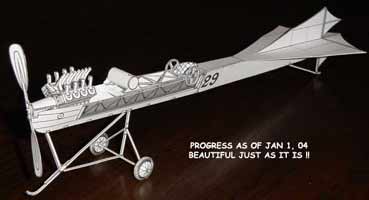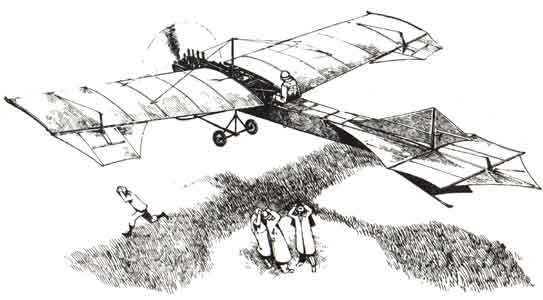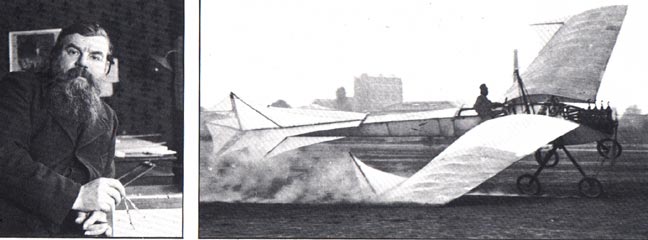


Leon Levavasseur and his Magnificent Magical 1907 Antoinette
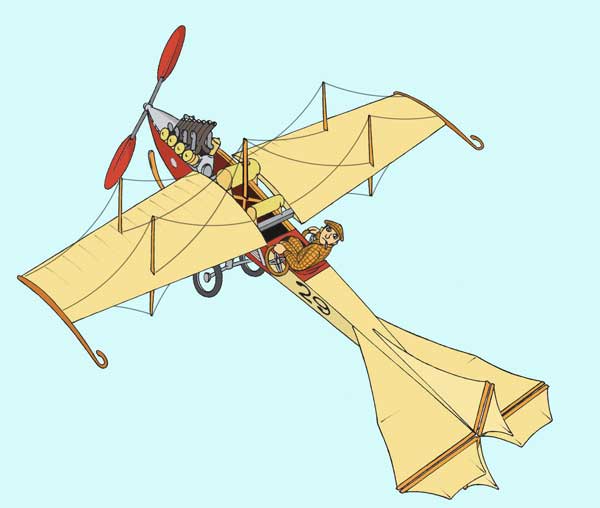
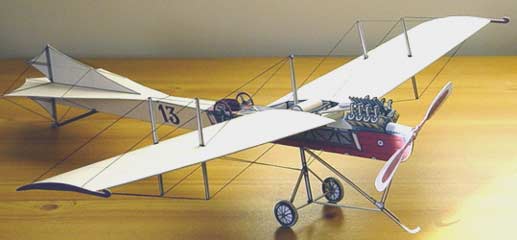
One of the early European Pioneers of manned flight was the French engineer and boat builder. Leon Levavasseur, whose graceful Antoinette was one of he first practical monoplane designs. The series of Antoinette airplanes used wing warping for lateral balance developed by the Wright brothers. The Antoinette helped introduce the concept of manned flight to Europeans.
The short-lived Antoinette company was named for the daughter of the director Jules Gastambide. Its fame owed much to its designer Léon Levavasseur, who also designed the fine Antoinette engines. The Antoinette IV, introduced in October 1908, was the first in a series of aerodynamically advanced monoplanes. It featured a slim fuselage, trapezoidal wings with marked dihedral, and cruciform tail. It was the first practical monoplane with ailerons, although they performed poorly and were replaced with wing warping in later models.
On June 12, Hubert Latham set a world record for monoplanes, staying aloft in his Antoinette for one hour and seven minutes. Although Latham failed in his two attempts to cross the English Channel flying Antoinette's, the plane won numerous prizes for distance and altitude with Latham and others piloting before the company dissolved in 1912.
Absolutely gorgeous! Great piece of work there and beautifully built. Will S.
Fantastic! My youngest son, Malcolm, was impressed, too. He says it looks like a bat in the back, a bird in the middle and like a tufted cat with whiskers up front. Carl T
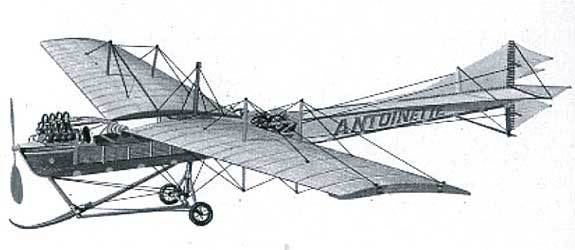 I've been doing a little of the coloring work to try out some ideas and have just started on the wings, which I figured would be the easiest bits. I design my models the way I build them, fuselage first! After Chips helpful input regarding up sizing, downsizing and your strange 'letter size' paper dimensions, I wound up re-drawing the model. When I started putting it together I found that because the Antoinette is a very peculiarly proportioned machine some of the pieces where very fiddly, so I resized it 25% bigger and wound up re-drawing a lot of it again!! You live and learn :-) The finished model will come with three sets of optional racing numbers, optional ailerons which were retro-fitted to some machines and hopefully there will be room to put on an extra engine so the magnificent V-16 powered Antoinette can be built. The model may be of the machine that Hubert Latham almost crossed the English Channel in before Bleriot, but that one has an enormous extended tail plane, which may be just too big to fit on! But there will be the option of his 'lucky 13' racing number. Derek-(the designer of this model)
I've been doing a little of the coloring work to try out some ideas and have just started on the wings, which I figured would be the easiest bits. I design my models the way I build them, fuselage first! After Chips helpful input regarding up sizing, downsizing and your strange 'letter size' paper dimensions, I wound up re-drawing the model. When I started putting it together I found that because the Antoinette is a very peculiarly proportioned machine some of the pieces where very fiddly, so I resized it 25% bigger and wound up re-drawing a lot of it again!! You live and learn :-) The finished model will come with three sets of optional racing numbers, optional ailerons which were retro-fitted to some machines and hopefully there will be room to put on an extra engine so the magnificent V-16 powered Antoinette can be built. The model may be of the machine that Hubert Latham almost crossed the English Channel in before Bleriot, but that one has an enormous extended tail plane, which may be just too big to fit on! But there will be the option of his 'lucky 13' racing number. Derek-(the designer of this model)
I first saw the Antoinette in "Those Magnificent Men In Their Flying Machines". A really pretty bird. Also featured (as I preach to the choir) was the Demoiselle, another pretty bird. You have those two in the mill. Again I see where this is leading. Another collection! Add the big Curtiss flown by Stuart Whitman's character, the Avro tri-plane that Terry-Thomas' character flew, and voila'! The other pretty birds, Sarah Miles and Irina Demick, well . . . You have done cut-outs of John Glenn and one of the racing ac's designer in your earlier work . . . why not them, too. Just a thought.
P. S. James Fox\'s character flew the Antoinette. Is this one of my favorite movies? Plum wore out the video tape copy years ago and have not been able to find another one; haven\'t seen it in years.
That\'s a beauty ! Your building skills are nothing short of exceptional. My hat's off. Question: Are all the struts and such paper as well? T.
yeah, baby! ;-) Mike
Wow. This has got to be one of the prettiest yet! Kell B
Thank you for continuing to send the really amazing paper models in pdf. They are really wonderful. I'm writing to alert you to one small correction on the Antoinette. The wing section ought to be two circle sections (arcs of a circle), with the radius of the "upper" surface less than the radius of the "lower" surface. The Antoinette's wings were interchangeable from right to left and had a symmetrical wing section (aerofoil), rather than the more modern aerofoil depicted. A couple of the modern Antoinette replicas have made use of the more wing section, but it is not the section used on the Antoinette of history. I'll be building mine (with the old wing section) this weekend. Thanks again,
Sirs: Just a quick note to say that this model came out gorgeous in stick and tissue and rubber power.. Fly's great too! Bill P
Antoinette VII
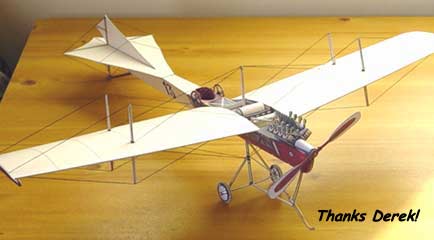
It was in 1908 that Levavasseur's monoplane first appeared. Although
the first Antoinette's were rather ungainly machines, Levavasseur
was to develop his basic
idea into a series of extremely elegant aircraft, far excelling
those of Bleriot in purely aesthetic qualities.
Levavasseur's interest in flight had begun in 1903 when he built the first petrol-engine aircraft to be freely tested In France. The machine, of unattractive bird form, was a failure, but this did not deter Levavasseur. He re-entered the field with the Gastambide-Mengin 1, ordered by his employer and another member of the firm in 1907, and delivered in February 1908.
 The aircraft, although unsuccessful, was interesting in one very
important respect: the aerofoil section of the wings.. Up to this
date most early aerofoil's had consisted of parallel-sided cambered
surfaces. Levavasseur, however, followed the example of Phillips,
and adopted a section with considerably less camber on the under-surface.
This produced as much lift as the parallel sided aerofoils, but
far less drag. Unfortunately, Levavasseur failed to appreciate
that a buff leading edge would have improved matters even further,
and used a sharp one, but this does not detract from his importance
as a promoter of the best type of wing section, with a high lift-to-drag
ratio.
The aircraft, although unsuccessful, was interesting in one very
important respect: the aerofoil section of the wings.. Up to this
date most early aerofoil's had consisted of parallel-sided cambered
surfaces. Levavasseur, however, followed the example of Phillips,
and adopted a section with considerably less camber on the under-surface.
This produced as much lift as the parallel sided aerofoils, but
far less drag. Unfortunately, Levavasseur failed to appreciate
that a buff leading edge would have improved matters even further,
and used a sharp one, but this does not detract from his importance
as a promoter of the best type of wing section, with a high lift-to-drag
ratio.
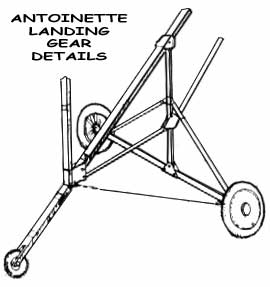 The wings of the Gastambide-Mengin 1 were pleasantly tapered,
but the fuselage was a massive affair perched on an ungainly four-wheeled
undercarriage, with the engine mounted in the nose and driving
an inefficient paddle-bladed propeller.
The wings of the Gastambide-Mengin 1 were pleasantly tapered,
but the fuselage was a massive affair perched on an ungainly four-wheeled
undercarriage, with the engine mounted in the nose and driving
an inefficient paddle-bladed propeller.
Levavasseur had no part, as far as is known, in the Antoinette III, otherwise designated the Ferber IX. His next aircraft, the Antoinette IV, was the world's first truly successful monoplane. This graceful aircraft was completed in October 1908, and in the course of a career that was lengthy by contemporary standards, it underwent a series of modifications, especially to the undercarriage.
As most attention at the time was concentrated on this machine's successor, the Antoinette V, it is impossible to trace all the modifications for lack of evidence. Nevertheless, the Antoinette IV ushered in the era of graceful Levavasseur monoplanes, the majority of them featuring a boat-shaped fuselage of triangular section, probably inspired by Levavasseur's earlier association with racing motor-boats.
Levavasseur's beautiful monoplane, Antoinette which had gained
the altitude record at the Reims meeting, remained a particular
favorite. The very large tapering wings were 42ft long and 9-8ft
wide at the base, and there was a long triangular tail plane with
a triangular fin and rudder. The slim braced fuselage of hollow
V section had a clear veneer casing at the front. An 8-cylinder
50hp Antoinette engine directly connected to the propeller gave
it a speed of about 44mph.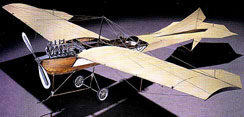
A present-day light aircraft pilot would find the control system decidedly tricky to operate. In addition to the familiar rudder bar, the pilot had to manipulate two hand wheels placed on either side of the cockpit. The one on the right controlled the elevators - rotating the wheel forward lowered the nose, as with a modern trim-wheel. The wheel on the left operated the warping mechanism whereby a forward rotation lowered the left wing.
Derek's "Model in Progress" Images
|
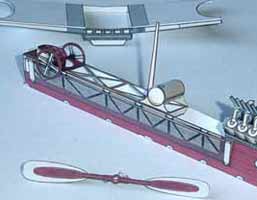
|
||
  |
||
|
|
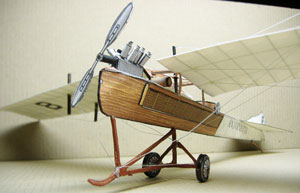 |
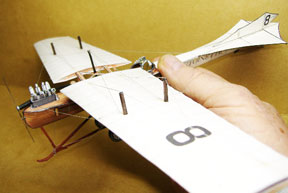 |
| These images of the Antoinette VII were submitted by Bob Martin. Thanks Bob! |
|

From an article of the day...
The magnificent Antoinette is perhaps the most beautiful aircraft
of the present day. Léon Levavasseur, an engineer and artist,
has designed it. It is this combination, that of technician and
artist, which gives us this brilliant design. It's name comes
from Antoinette Gastambide, the daughter of the manufacturer company
director.
It's pilot, Hubert Latham and the designer had a true friendship.
They were always talking about the plane. The plane had an unusual
boat-shape fuselage; this design, combined with the elegant wings,
afforded the plane an outstanding look. An eight-cylinder, 50hp
water-cooled Antoinette engine powered it. The 1908 version had
ailerons, however the machine they brought to Reims used wing
warping, with better results. Simply beautiful!
Recently, Latham has been active in his magnificent flying machine.
On June 5, 1908 he set a world record for monoplanes, staying
aloft for one hour and seven minutes and in July, he made two
attempts to cross the English Channel.
On the 19th, he took off from Calais, on the French cost, but his engine failed after 7.6 miles and he had to be rescued from the sea by the crew from a French destroyer.He tried again on the 27th, just two days after Blériot´s fantastic crossing. The flight was normal till he saw the English coast. However as he was approaching the shore, just 1.6 km (one mile) away, the engine failed and the plane crashed in the sea. Latham has recovered from these events and brought another aero plane for the Reims meeting. Last Monday, when I talked with him about his flight here in Bétheny he felt he had little chance in the speed races, but would try to win the Grand Prix distance race and the altitude prize.
Also, flying 96 miles in 2h 13m 9.6 seconds in
his Antoinette No. 29. (Due in part to a larger gasoline tank)
he lead the Grand Prix, beating both Paulhan´s Voisin record,
81 miles and De Lambert´s Wright plane distance, 72 miles. Tomorrow
will be the last day for someone to beat his distance in the Grand
Prix and take home the prize! I think that Monsieur Blériot
and Mr. Curtiss will not make any other attempt to beat him because
they have their eyes toward the Golden Bennett trophy on Saturday.
From article by Michel Leseurre WWW correspondent in the course
at Bétheny (Reims Meeting)
Note- On Sunday, August 29, Latham succeeded. At the
racecourse at Bétheny (Reims meeting), piloting his Antoinette,
Latham won the prize for highest altitude, with 509 ft.
Specifications for the Antoinette
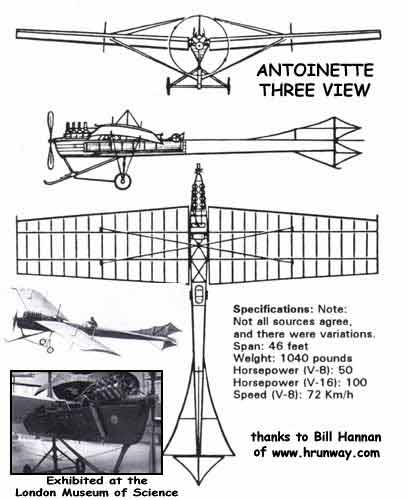 |
Length: 37 ft 9 in Wingspan: 42 ft 8 in Height: 9 ft 10 in Wing area: 538 ft² Gross weight: 1,300 lb Powerplant: 1 × Antoinette V8 engine, 50 hp Performance Maximum speed: 44 mph |



